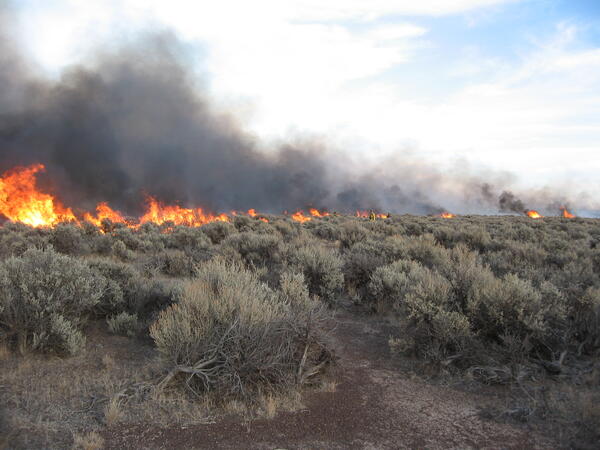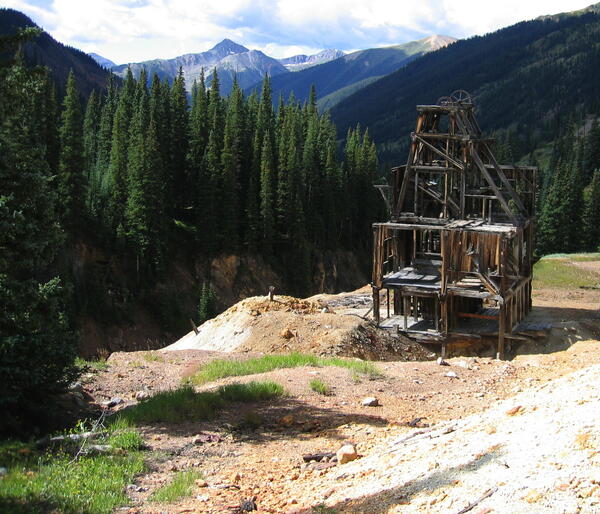Photograph of iron(III) oxyhydroxides (yellow-brown color in two left-hand tubes collected on folded filter paper) that was produced in iron(II)-containing groundwater by the addition of nitrate. The tube on the right is a filter collected from the same groundwater before nitrate was added.
Images
Photograph of iron(III) oxyhydroxides (yellow-brown color in two left-hand tubes collected on folded filter paper) that was produced in iron(II)-containing groundwater by the addition of nitrate. The tube on the right is a filter collected from the same groundwater before nitrate was added.

U.S. Geological Survey (USGS) scientists collecting bed-sediment samples from Suwanee Creek, Gwinnett County, Georgia, on May 23, 2007.
U.S. Geological Survey (USGS) scientists collecting bed-sediment samples from Suwanee Creek, Gwinnett County, Georgia, on May 23, 2007.
Soil sampling in Eastern Colorado indicated that some chemicals introduced to nonirrigated farmland through biosolids application persisted through 468 days, and some chemicals were sufficiently mobile to be detected in soil as deep as 126 centimeters below land surface.
Soil sampling in Eastern Colorado indicated that some chemicals introduced to nonirrigated farmland through biosolids application persisted through 468 days, and some chemicals were sufficiently mobile to be detected in soil as deep as 126 centimeters below land surface.

Left: USGS Employee Sherry Wren removing a square meter of surface sediment in pickleweed dominated marsh along the Petaluma River (California), for a study designed to investigate the role of marsh plant root zone on the cycling of mercury. Photographer: L. Windham-Myers. Date: 4/4/2006
Left: USGS Employee Sherry Wren removing a square meter of surface sediment in pickleweed dominated marsh along the Petaluma River (California), for a study designed to investigate the role of marsh plant root zone on the cycling of mercury. Photographer: L. Windham-Myers. Date: 4/4/2006

Wildfire is one of the largest sources of re-released mercury to the atmosphere and a component to the widespread movement of inorganic mercury to aquatic sediments.
Wildfire is one of the largest sources of re-released mercury to the atmosphere and a component to the widespread movement of inorganic mercury to aquatic sediments.

A USGS scientist collects a water sample for analysis of mineral particles known as colloids. Toxic metals (such as copper in excess) bind to the particles, which are then ingested by aquatic animals.
A USGS scientist collects a water sample for analysis of mineral particles known as colloids. Toxic metals (such as copper in excess) bind to the particles, which are then ingested by aquatic animals.

USGS scientist collecting water-level data from an observation well during an aquifer test at the Naval Air Warfare Center Fractured Rock Research Site, West Trenton, New Jersey.
USGS scientist collecting water-level data from an observation well during an aquifer test at the Naval Air Warfare Center Fractured Rock Research Site, West Trenton, New Jersey.

Close up of a cyanobacteria bloom on Elysian Lake, Minnesota
Close up of a cyanobacteria bloom on Elysian Lake, Minnesota

Voyageurs National Park (VNP), a pristine setting with abundant lakes, wetlands, and streams situated on granitic bedrock, is located near northern Minnesota's border with Canada. Long-term studies at VNP have revealed trends in mercury concentration in precipitation, surface water, and fish.
Voyageurs National Park (VNP), a pristine setting with abundant lakes, wetlands, and streams situated on granitic bedrock, is located near northern Minnesota's border with Canada. Long-term studies at VNP have revealed trends in mercury concentration in precipitation, surface water, and fish.
Algal and Other Environmental Toxins Laboratory — Lawrence, Kansas. Cyanobacterial accumulation along with a dead fish
Algal and Other Environmental Toxins Laboratory — Lawrence, Kansas. Cyanobacterial accumulation along with a dead fish

Tree swallow nestlings (Tachycineta bicolor) in a nesting box
Tree swallow nestlings (Tachycineta bicolor) in a nesting box
Typical San Francisco Bay wetland habitat dominated by pickleweed (Salicornia pacifica).
Typical San Francisco Bay wetland habitat dominated by pickleweed (Salicornia pacifica).

The Silver Ledge Mine in the area of upper Mineral Creek, near Silverton, Colorado, is one of many abandoned mine sites in the watershed.
The Silver Ledge Mine in the area of upper Mineral Creek, near Silverton, Colorado, is one of many abandoned mine sites in the watershed.

Biosolids from a wastewater treatment plant were loaded onto trucks for transport to the field. A team of USGS scientists and their colleagues collected samples of biosolids for analysis from freshly exposed surfaces created by the machinery used to load the biosolids onto trucks.
Biosolids from a wastewater treatment plant were loaded onto trucks for transport to the field. A team of USGS scientists and their colleagues collected samples of biosolids for analysis from freshly exposed surfaces created by the machinery used to load the biosolids onto trucks.
Grey Tree Frog

USGS scientists extracted DNA from aquifer materials and analyzed the DNA for microbial community composition using several methods.
USGS scientists extracted DNA from aquifer materials and analyzed the DNA for microbial community composition using several methods.

John Clune and Connie Loper, PA Water Science Center, processing an emerging-contaminants bed-sediment sample at Rock Creek near Gettysburg, PA.
John Clune and Connie Loper, PA Water Science Center, processing an emerging-contaminants bed-sediment sample at Rock Creek near Gettysburg, PA.

John Clune, PA Water Science Center, processing an emerging-contaminants bed-sediment sample at Lititz Run.
John Clune, PA Water Science Center, processing an emerging-contaminants bed-sediment sample at Lititz Run.

John Clune, PA Water Science Center, collecting an emerging-contaminants bed-sediment sample at the Susquehanna River at Danville,PA.
John Clune, PA Water Science Center, collecting an emerging-contaminants bed-sediment sample at the Susquehanna River at Danville,PA.
Cement Creek following storm event in July, 2004. Note the orange discoloration of the stream derived from weathering of bedrocks and from mined areas. This type of event happens frequently in the Animas Watershed near Silverton, Colorado. View is to the south, with Kendall Mountain in the distance.
Cement Creek following storm event in July, 2004. Note the orange discoloration of the stream derived from weathering of bedrocks and from mined areas. This type of event happens frequently in the Animas Watershed near Silverton, Colorado. View is to the south, with Kendall Mountain in the distance.








